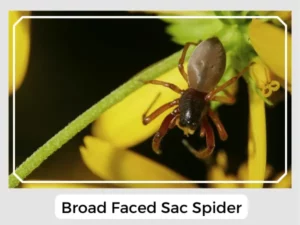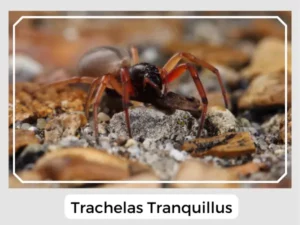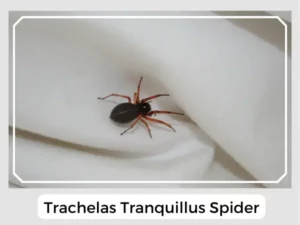The broad-faced sac spider belongs to the ground sac spiders family. These spiders call North America their home. Ready to uncover some cool facts about them?

Photo Credit: Steve Leitkam

Photo Credit: Patrick Connolly
After mating, a female spider lays a white egg sac containing around 30-50 eggs.
Spiderlings stay close to their mothers until they are old enough to fend for themselves.
While not using their webs to catch prey, they will construct silken retreats in which they hide during the day.
Yes, broad-faced sac spiders have venom, but it’s primarily used to subdue their prey.
Yes, they can bite humans, but it’s usually in self-defense. While the bite itself isn’t very deadly, causing only redness and swelling, as a result of this spider feeding on dead insects, there is a chance of secondary infections from this bite.

Photo Credit: James Derek Dwyer
The broad-faced sac spider plays a crucial role in our ecosystems. As both predator and prey, these spiders contribute to controlling insect populations, which can benefit agricultural areas by reducing pest species that may harm crops. In terms of behavior, Trachelas tranquillus is primarily nocturnal, actively hunting its prey at night. During the day, they retreat to their silken nests, often found in protected areas like under rocks or inside fallen leaves.
Natural Predator: Natural predators of the broad-faced sac spider include birds, larger spiders, and insectivores such as certain species of small mammals. These predators help maintain a healthy balance within the ecosystem by keeping the spider population in check.
Prey-Predator Dynamics: In the prey-predator relationship, the broad-faced sac spider occupies an interesting niche. While it preys upon dead insects, thus cleaning the environment, it also falls prey to various nocturnal hunters. This dynamic is vital for energy transfer within food webs and for controlling the populations of other species.
Relationship with Humans: The relationship between humans and the broad-faced sac spider is generally unobtrusive. Although they can bite when threatened, such incidents are rare and usually not serious. However, they can be considered beneficial to humans as they consume pests that might otherwise damage household goods or agricultural products.
| Lifespan | 1 year |
| Distribution | Canada and the United States |
| Habitat | Warm, dry areas |
| Diet | Scavengers, feasting on dead insects and spiders |
In summary, the broad-faced sac spider is an ecological ally, balancing ecosystems and harmoniously coexisting with humans.
The broad-faced sac spider belongs to the ground sac spiders family. These spiders call North America their home. Ready to uncover some cool facts about them?

Photo Credit: Steve Leitkam

Photo Credit: Patrick Connolly
After mating, a female spider lays a white egg sac containing around 30-50 eggs.
Spiderlings stay close to their mothers until they are old enough to fend for themselves.
While not using their webs to catch prey, they will construct silken retreats in which they hide during the day.
Yes, broad-faced sac spiders have venom, but it’s primarily used to subdue their prey.
Yes, they can bite humans, but it’s usually in self-defense. While the bite itself isn’t very deadly, causing only redness and swelling, as a result of this spider feeding on dead insects, there is a chance of secondary infections from this bite.

Photo Credit: James Derek Dwyer
The broad-faced sac spider plays a crucial role in our ecosystems. As both predator and prey, these spiders contribute to controlling insect populations, which can benefit agricultural areas by reducing pest species that may harm crops. In terms of behavior, Trachelas tranquillus is primarily nocturnal, actively hunting its prey at night. During the day, they retreat to their silken nests, often found in protected areas like under rocks or inside fallen leaves.
Natural Predator: Natural predators of the broad-faced sac spider include birds, larger spiders, and insectivores such as certain species of small mammals. These predators help maintain a healthy balance within the ecosystem by keeping the spider population in check.
Prey-Predator Dynamics: In the prey-predator relationship, the broad-faced sac spider occupies an interesting niche. While it preys upon dead insects, thus cleaning the environment, it also falls prey to various nocturnal hunters. This dynamic is vital for energy transfer within food webs and for controlling the populations of other species.
Relationship with Humans: The relationship between humans and the broad-faced sac spider is generally unobtrusive. Although they can bite when threatened, such incidents are rare and usually not serious. However, they can be considered beneficial to humans as they consume pests that might otherwise damage household goods or agricultural products.
| Lifespan | 1 year |
| Distribution | Canada and the United States |
| Habitat | Warm, dry areas |
| Diet | Scavengers, feasting on dead insects and spiders |
In summary, the broad-faced sac spider is an ecological ally, balancing ecosystems and harmoniously coexisting with humans.